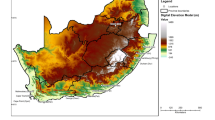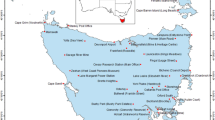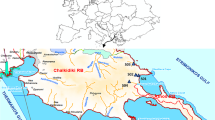Abstract
Multivariate extreme value models are used to investigate the combined behaviour of several weather variables. To investigate joint dependence of extreme rainfall events, a multivariate conditional modelling approach was considered to analyse the behaviour of joint extremes of rainfall events at selected weather stations in South Africa. Moreover, 1-day to 5-day indices of rainfall events were constructed to investigate the frequencies and intensities of rainfall events for selected weather stations. Then, the conditional multivariate modelling was fitted to investigate dependence between series of extreme rainfall events. The conditional multivariate modelling has provided all forms of dependence, using Laplace marginal transformations, for which all weather stations are not equally extreme. Bootstrap sampling was also employed to account for models uncertainty in computing the prediction standard errors and compared with the prediction obtained from the conditional modelling that was fitted to extreme data. The results obtained from predictions reflected both the marginal and the dependence features, as well as the extremal dependence structure described consistently for indices of rainfall events between weather stations. The modelling framework and results of this study contribute towards understanding the salient features on the extremal dependence of rainfall extremes which are associated with, e.g. flash floods and landslides. This knowledge has practical applications in disaster risk preparedness by communities.




Similar content being viewed by others
References
Seneviratne, S.I., Nicholls, N., Goodess, S., Kanae, J., Kossin, Y., Luo, J., et al. (2012). Changes in climate extremes and their impacts on the natural physical environment. In: managing the risks of extreme events and disasters to advance climate change adaptation. A special report of working groups I and II of the intergovernmental panel on climate change (IPCC). Cambridge University Press, Cambridge, UK, and New York, NY, USA, pp. 109-230.
Jones, M. R., Blenkinsop, S., Fowler, H. J., & Kilsby, C. G. (2014). Objective classification of extreme rainfall regions for the UK and updated estimates of trends in regional extreme rainfall. International Journal of Climatology, 34(3), 751–765.
Lestari, S., King, A., Vincent, C., Karoly, D., & Protat, A. (2019). Seasonal dependence of rainfall extremes in and around Jakarta. Indonesia. Weather and Climate Extremes, 24, 100202.
Avila, A., Guerrero, F. C., Escobar, Y. C., & Justino, F. (2019) Recent Precipitation Trends and Floods in the Colombian Andes. Water, 11, 379.
Brunetti, M. T., Peruccacci, S., Rossi, M., Luciani, S., Valigi, D., & Guzzetti, F. (2010). Rainfall thresholds for the possible occurrence of landslides in Italy. Natural Hazards and Earth System Sciences, 10(3), 447–458.
Singh, R. G., Forbes, C., Chiliza, G., Diop, S., Musekiwa, C., & Claassen, D. (2011). Landslide geohazards in South Africa: Landslide susceptibility mapping, socio-economic impacts, mitigation and remediation measures. Council for Geoscience Report Number, 2011–0016, 2011.
Paige-Green, P. (1989). The influence of geotechnical properties on the performance of gravel wearing course materials. PhD thesis, University of Pretoria, South Africa.
ECHO (2019). South Africa - Floods and landslides, Daily Flash of 24 April 2019. https://erccportal.jrc.ec.europa.eu/FlashAnchor Accessed on 02 July 2020.
News24. (2019). Durban floods: Be vigilant in KZN. Available online: https://www.getaway.co.za/travel-news/durban-floods-be-vigilant-in-kzn/
De Waal, J. H., Chapman, A., & Kemp, J. (2017). Extreme 1-day rainfall distributions: Analysing change in the Western Cape. South African Journal of Science, 13(7–8), 1–8.
Maposa, D., Cochran, J. J., & Lesaoana, M. (2016). Modelling non-stationary annual maximum flood heights in the lower Limpopo River basin of Mozambique. Jmb: Journal of Disaster Risk Studies, 8(1).
Westra, S., Fowler, H.J., Evans, J.P., Alexander, L.V., Berg, P., Johnson, F., Kendon, E.J., Lenderink, G., & Roberts, N.M. (2014). Future changes to the intensity and frequency of short duration extreme rainfall. Reviews of Geophysics, 52(3), 522–555.
Capra, P., Fougres, A. L. & (2000). Estimation of a bivariate extreme value distribution. Extremes, 3(4), 311–329.
Coles, S. G., & Tawn, J. A. (1994). Statistical methods for multivariate extremes: an application to structural design. Journal of the Royal Statistical Society: Series C (Applied Statistics), 43(1), 1–31.
Einmahl, J. H., De Haan, L., & Piterbarg, V. I. (2001). Non-parametric estimation of the spectral measure of an extreme value distribution. The Annals of Statistics, 29(5), 1401–1423.
Kiriliouk, A., Rootzn, H., Segers, J., & Wadsworth, J.L. (2019). Peaks over thresholds modelling with multivariate generalized Pareto distributions. Technometrics, 61(1), 123–135.
Naveau, P., Guillou, A., Cooley, D., & Diebolt, J. (2009). Modelling pairwise dependence of maxima in space. Biometrika, 96(1), 1–17.
Rootzn, H., & Tajvidi, N. (2006). Multivariate generalized Pareto distributions. Bernoulli, 12(5), 917–930.
Heffernan, J. E., & Tawn, J. A. (2004). A conditional approach for multivariate extreme values (with discussion). Journal of the Royal Statistical Society: Series B (Statistical Methodology), 66(3), 497–546.
Du Plessis, J. A., & Burger, G. J. (2015). Investigation into increasing short-duration rainfall intensities in South Africa. Water SA, 41(3), 416–424.
Mason, S. J., Waylen, P. R., Mimmack, G. M., Rajaratnam, B., & Harrison, J. M. (1999). Changes in extreme rainfall events in South Africa. Climatic Change, 41(2), 249–257.
van Buuren, S. (2019). Package mice: Multivariate imputation by chained equations. CRAN Repos.
Pickands, J. (1981). Multivariate extreme value distributions. In Proceedings 43rd Session(2:859–878). International Statistical Institute.
Jockovic, J. (2016). Quantile estimation for the generalized pareto distribution with application to finance. Yugoslav Journal of Operations Research, 22(2).
Gilleland, E., & Katz, R. W. (2011). New software to analyse how extremes change over time. Eos, Transactions American Geophysical Journal, 92(2), 13–14.
Azzalini, A. (1996). Statistical Inference: Based on the likelihood. London, UK: Chapman and Hall.
Rao, C. R. (1973). Linear statistical inference and its applications. New York, USA: Wiley.
Keef, C., Tawn, J., & Svensson, C. (2009). Spatial risk assessment for extreme river flows. Journal of the Royal Statistical Society: Series C (Applied Statistics), 58(5), 601–618.
Keef, C., Papastathopoulos, I., & Tawn, J. A. (2013). Estimation of the conditional distribution of a multivariate variable given that one of its components is large: Additional constraints for the Heffernan and Tawn model. Journal of Multivariate Analysis, 115, 396–404.
Southworth, H., Heffernan, J. E., & Metcalfe, P. D. (2017). Texmex: Statistical modelling of extreme values. R package version, 2, 4.
Stephenson, A.G. (2018). evd: Functions for extreme value distributions. R package version 2.3-3. https://cran.r-project.org
Stephenson, A.G. (2016). ismev: An introduction to statistical modeling of extreme values. R package version 1.41. http://www.ral.ucar.edu/ericg/softextreme.php
Johnson, J. S. (2010). Modelling dependence in extreme environmental events. PhD thesis, School of Mathematics and Statistics, Newcastle University.
Bell, F. G., & Maud, R. R. (2000). Landslides associated with the colluvial soils overlying the Natal Group in the greater Durban region of Natal. South Africa. Environmental geology, 39(9), 1029–1038.
Debusho, L.K., & Diriba, T.A. (2021). Conditional modelling approach to multivariate extreme value distributions: application to extreme rainfall events in South Africa.
Diriba, T. A., Debusho, L. K., & Botai, O.J. (2020). Modelling dependence structures of extreme wind speed using bivariate distribution: a Bayesian approach. Environmental and Ecological Statistics, 27, 319-362.
Cheng, L., Gilleland, E., Heaton, M. J., & AghaKouchak, A. (2014). Empirical Bayes estimation for the conditional extreme value model. The ISI Journal for the Rapid Dissemination of Statistics Research, 3(1), 391-406.
Acknowledgements
The authors are very indebted to the University of South Africa for the financial support. The authors also would like to thank the South African Weather Service for providing the data.
Author information
Authors and Affiliations
Contributions
TAD and LKD conceptualised the research. TAD obtained the data and cleaned it. TAD and LKD analysed the data, and TAD drafted the original manuscript. TAD and LKD reviewed the manuscript. TAD and LKD read and approved the final manuscript. TAD and LKD approved the final manuscript and agreed to submit it for publication.
Corresponding author
Ethics declarations
Conflicts of Interest
The authors declare that they have no conflict of interest.
Additional information
Publisher’s Note
Springer Nature remains neutral with regard to jurisdictional claims in published maps and institutional affiliations.
Appendices
A Appendix
Details on the bootstrapping procedure are given as follows:
-
(1)
Convert the recorded extreme data to have Laplace margins following the marginal transformation techniques.
-
(2)
Calculate the nonparametric bootstrap sample by sampling with replacement from the new dataset obtained in step 1.
-
(3)
Convert the marginal values of the bootstrap sample obtained in step 2, provided the marginal distributions are all Laplace and preserving the connections between the ranked points in each marginal component. Particularly, for each \(i=1, \ldots , d\), replace the ordered sample of the component \(Y_i\) margin with the ordered sample of the component from the standard Laplace marginally transformed distribution.
-
(4)
Transform the resulting sample obtained in step 3 back to the original margins by using the Laplace marginal transformation technique that was estimated from the first recorded extreme data. Note that the new extreme data that are produced following this approach have univariate marginal distributions for which the exceedances are simulated from the fitted GPD model. Also, the dependence structures are entirely consistent with the extreme data as determined by the dependence between components of the variables.
B Appendix
Profile log-likelihood surface for indices of rainfall events for Cape Point, Durban, George, Port Elizabeth and Ulundi from top to bottom, respectively. (\(\alpha _{R_2|R_1},\beta _{R_2|R_1}\)), (\(\alpha _{R_3|R_1},\beta _{R_3|R_1}\)), (\(\alpha _{R_4|R_1},\beta _{R_4|R_1}\)), (\(\alpha _{R_5|R_1},\beta _{R_5|R_1}\)); \(\mathbf{a }- {\alpha }\), \(b- {\beta }\) left to right row, respectively
Rights and permissions
About this article
Cite this article
Diriba, T.A., Debusho, L.K. Statistical Modelling of Extreme Rainfall Indices using Multivariate Extreme Value Distributions. Environ Model Assess 26, 543–563 (2021). https://doi.org/10.1007/s10666-021-09766-6
Received:
Accepted:
Published:
Issue Date:
DOI: https://doi.org/10.1007/s10666-021-09766-6





